Fiat Money

What Is Fiat Money?
Fiat money (or fiat currency) is government-issued currency which is not backed by traditional forms of value or commodities like gold or silver. In other words, fiat money is issued based on the issuing government’s national credit using future tax income as a reserve. Currently, almost all countries issue their own form of fiat money.
History of Fiat Money
The beginning of fiat money was in 1973, when the U.S. dollar became so devalued in its exchange rate to other currencies it trigger actions that would cause the collapse of the Bretton Woods system.
Initially, paper money was simply a certificate that stated the bearer owned a stored precious metal money like gold or silver. These notes or certificates were essentially demand-notes that could be exchanged with the bank for real gold upon presentation.
The Bretton Woods system founded in 1944 was a monetary system of gold-backed currency, which ruled that US dollar’s value would be pegged to a fixed amount of gold while other world currencies would be pegged to the US dollar. This decision was made as most of the Allied nations had exhausted their gold supply fighting in World War II meanwhile the United States held two-thirds of the world’s gold reserves, making it the only likely candidate to support the global system. All currencies were thus backed by U.S dollars but essentially by gold which had been the accepted global store of value since the beginning of civilized trade.
On August 15,1971, President Nixon announced the suspension of any U.S. dollars being further converted to gold. He said in his speech, "I have directed Secretary Connally to suspend temporarily the convertibility of the American dollar except in amounts and conditions determined to be in the interest of monetary stability and in the best interests of the United States."
It should be noted that our current fiat money was in large part a creation of a U.S. national default and not the evolution of technology or financial strategy.
Profound Impact of Fiat Money
After the collapse of the Bretton Woods system, we entered into a world of fiat money which is essentially money that issued unbacked by any traditional forms of value like gold. The money issuance power is also squarely in the hands of central banks and authorities.
Without gold or commodities backing Fiat currency, it only has value because it is agreed upon by the governments that maintain it and the parties exchanging it agree on its value.
Although the gold was stripped from Fiat currency, the US dollar is still the de facto world currency and the Federal Reserve, a by-product of the collapse of the Bretton Woods agreement, determines its issuance. This is thanks largely in part to Nixon and Henry Kissinger’s establishment of the Petrodollar.
Fiat currency could be viewed as “monetary colonization” as one country's money and monetary policies, the United States, is the main influencer of all other countries globally.
Image via Shutterstock

